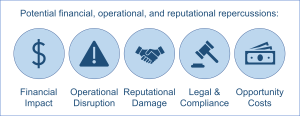5.3 Balancing the Cost of Risk and the Cost of Managing Risk
Having delved into the concept of risk and the quantification of risk through RPN in Section 5.2, it becomes evident that risks are an inherent part of business operations. While it might seem that firms should strive to eliminate all risks, aiming for a utopian business environment free from uncertainties or disruptions, this perspective warrants reconsideration for several reasons:
- Not Necessary: Sometimes, certain risks might be so infrequent or minor that the cost of preventing them exceeds the potential damage. For instance, a local retailer might not need to invest heavily in advanced cybersecurity measures if they conduct most of their business offline and handle minimal sensitive data.
- Not Possible: There are inherent risks in every venture that simply cannot be eliminated. For example, a farming business cannot control weather conditions. While they can mitigate the impact of unexpected weather events with insurance or diversifying crops, they can’t eliminate the risk of bad weather entirely.
- Prohibitively Expensive: In some cases, the cost of completely eliminating a risk could be so high that it would render the business unprofitable. A small e-commerce startup might not be able to afford the same level of supply chain redundancy as a global e-commerce giant, even if it would eliminate supply chain disruptions.
In the context of these realities, organizations need to be judicious in how they approach risk management. One effective strategy is to meticulously document both the costs associated with risks and the costs tied to managing those risks. The cost of risk encapsulates the potential financial, operational, and reputational repercussions a business might face due to unforeseen events. Conversely, the cost of managing risk denotes the investments a business allocates towards strategies, tools, and resources to prevent, mitigate, or recover from disruptions. At its essence, risk management is about ensuring that the combined weight of the cost of risks and the cost of management is minimized, striking a balance that promotes both operational resilience and financial viability.
5.3.1 Cost of Risks
Building on the foundation laid out in the previous section, it’s clear that while risks are inherent to any business operation, their associated costs can vary in magnitude and impact. The cost of risk is not just a monetary value but a comprehensive measure that encapsulates various potential repercussions a business might face. These costs can manifest in several ways:

- Financial Impact: This is the direct monetary loss a business might incur due to disruptions. It could arise from lost sales, penalties, or unforeseen expenses resulting from events that disrupt regular business operations.
- Operational Disruption: Risks can lead to interruptions in daily operations. This could mean halted production lines, disrupted supply chains, or even complete shutdowns in extreme scenarios.
- Reputational Damage: Beyond tangible costs, risks can tarnish a company’s reputation. A tarnished brand image can erode customer trust, leading to long-term financial implications as the business might need to invest more in rebuilding its image and regaining customer confidence.
- Legal and Compliance Implications: Certain risks can lead to legal challenges or regulatory penalties. These not only involve direct financial penalties but also the associated costs of legal consultations, court proceedings, and potential settlements.
- Opportunity Costs: When disruptions occur, businesses might miss out on potential opportunities. This could be in the form of lost sales, missed partnerships, or even foregone investments due to the time and resources spent on managing the disruption.
To provide a tangible perspective on these cost categories, consider the Suez Canal blockade by the Ever Given. The disruption led to a significant financial impact, with global trade facing delays and losses valued at up to $10 billion each day. The operational implications were vast, with over 400 ships stranded, causing potential production stoppages and logistical challenges across industries. Evergreen Marine, the operator of Ever Given, risked reputational damage, potentially affecting its future business endeavors. Legal challenges loomed as the ship’s owners and insurers faced claims from canal authorities and potential lawsuits from affected businesses. Amidst this chaos, many businesses, especially those with perishable goods or time-sensitive products, encountered the opportunity costs of missed sales and delayed market entries. This incident underscores the multifaceted nature of the costs associated with risks and the importance of effective risk management.
5.3.2 Cost of Managing Risks
While the cost of risks highlights the potential repercussions of unforeseen events, the cost of managing risks focuses on the investments made by businesses to prevent, mitigate, or recover from such disruptions. It’s essential to understand that managing risks doesn’t necessarily mean eliminating them but rather strategically addressing them to minimize their impact.

The cost of managing risks can be categorized into various components:
- Preventive Measures: These are proactive steps taken to avoid potential risks. It includes investments in training, technology, and infrastructure. For instance, a company might invest in advanced cybersecurity software to prevent potential cyberattacks or conduct regular employee training sessions to ensure compliance with safety protocols.
- Mitigation Strategies: Even with preventive measures in place, not all risks can be avoided. Mitigation strategies are designed to reduce the impact of risks that do materialize. This could involve diversifying suppliers to avoid supply chain disruptions or having backup systems in place to ensure business continuity in the event of technical failures.
- Recovery Plans: These are post-event strategies to bring operations back to normal after a disruption. It includes crisis management teams, insurance policies, and contingency plans. For example, after the 2011 earthquake and tsunami in Japan, Toyota’s robust recovery plan, built on their prior risk management practices, enabled them to bounce back faster than many competitors.
- Monitoring and Evaluation: Continuous monitoring of potential risks and evaluating the effectiveness of current risk management strategies is crucial. This involves regular audits, feedback mechanisms, and updating risk management practices based on lessons learned.
- Opportunity Costs of Risk Management: Just as there are opportunity costs associated with risks, there are also opportunity costs tied to risk management. For instance, funds allocated to risk management could have been invested elsewhere for potential growth. However, it’s essential to weigh these opportunity costs against the potential costs of not managing risks.
To illustrate the cost of managing risks, consider the Ever Given incident in the Suez Canal. While the canal authorities had preventive measures in place, the incident highlighted the need for more robust mitigation strategies, such as alternative routes or advanced navigation systems. The recovery costs involved not just freeing the ship but also managing the backlog of vessels and addressing the cascading effects on global trade. Continuous monitoring and evaluation would involve assessing navigation protocols, ship sizes, and canal infrastructure to prevent similar incidents in the future.
5.3.3 Balancing the Cost of Risk and the Cost of Managing Risk
Risk management is inherently a balancing act. Businesses are constantly weighing the potential repercussions of unforeseen events against the investments required to mitigate or recover from such disruptions. It’s crucial to understand that while risks are an inevitable part of business operations, over-investing in their management can be as detrimental as under-preparation.
The key lies in strategic prioritization. By identifying risks, which will be discussed in the upcoming sections on risk identification and the risk management process, organizations can determine which threats warrant significant investment and which can be managed with minimal resources. This approach ensures that businesses allocate their resources effectively, optimizing the balance between potential risk repercussions and the costs tied to risk management. In doing so, they can navigate uncertainties in a manner that promotes both operational resilience and financial stability.